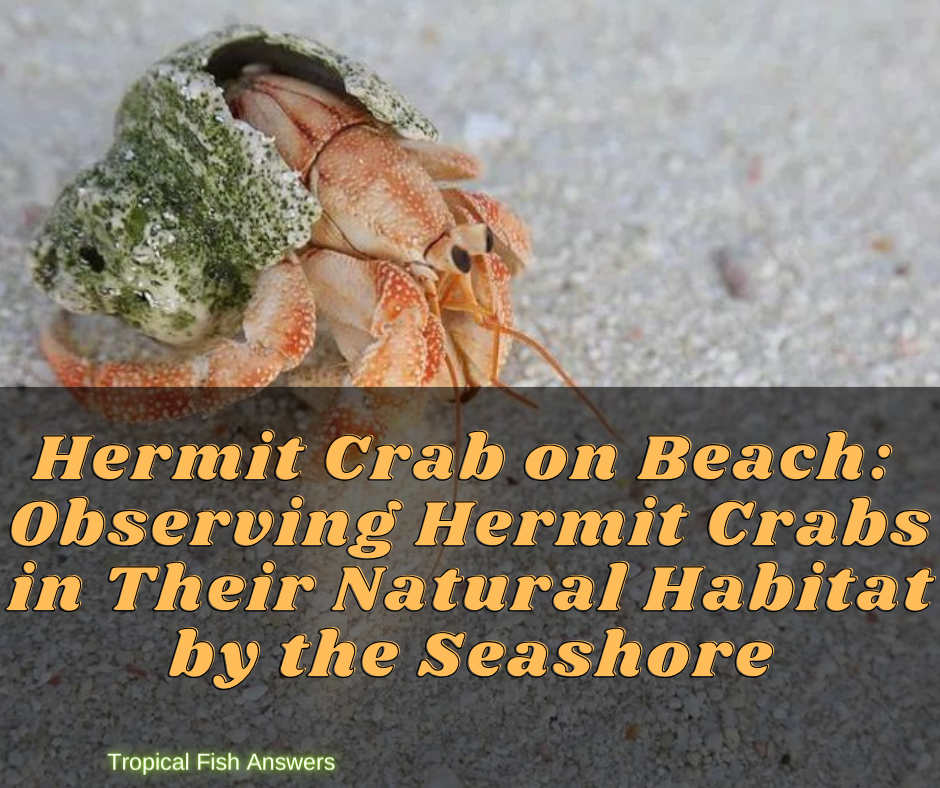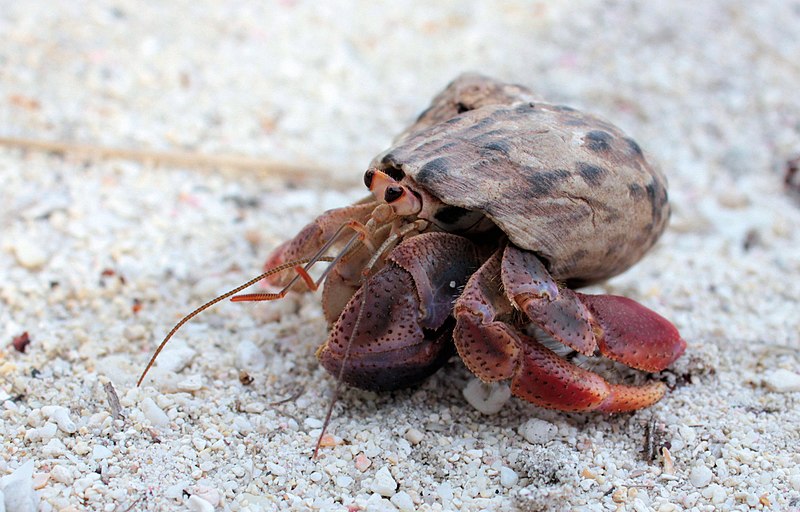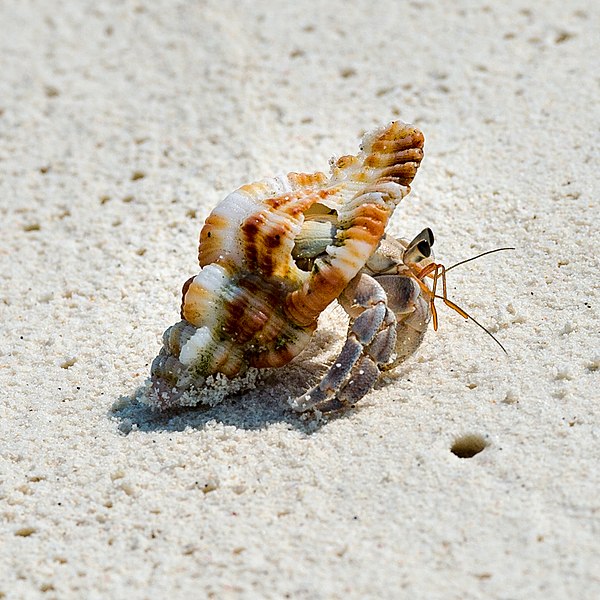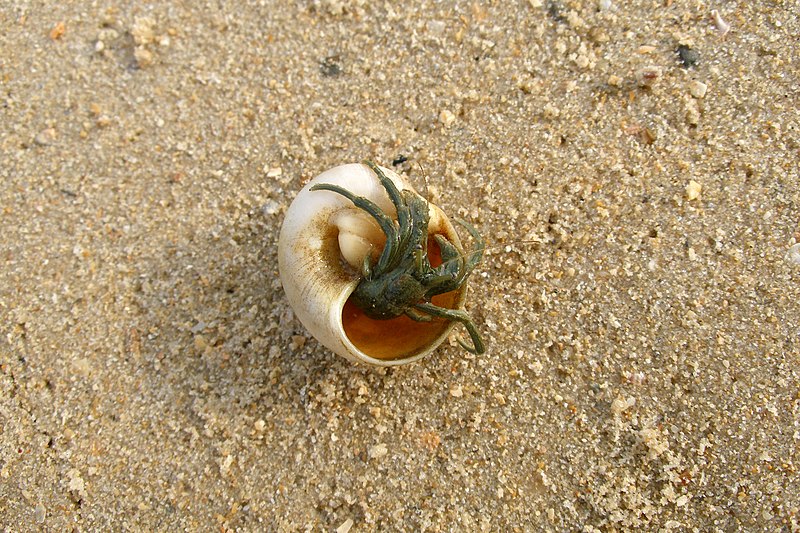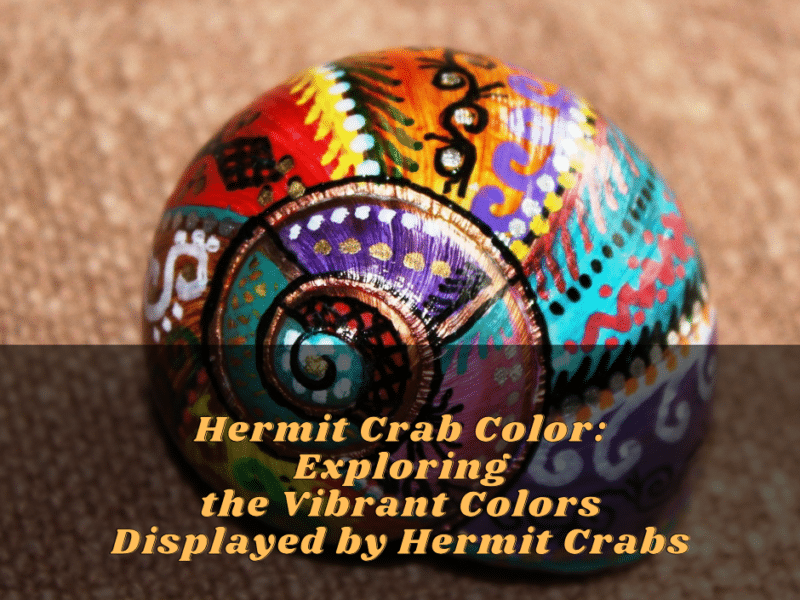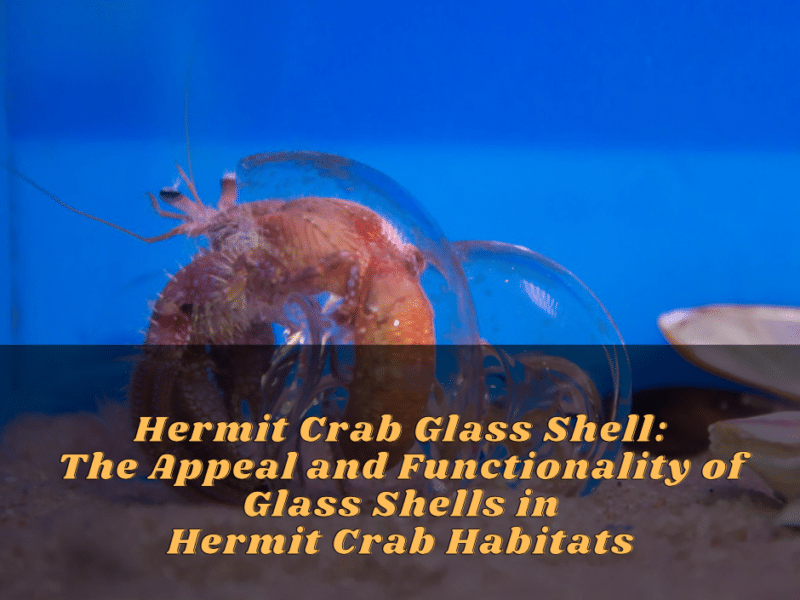Introduction
The beach is a fascinating place filled with unique and intriguing creatures. Among them, hermit crabs stand out with their curious behavior and captivating appearance. Observing hermit crabs in their natural habitat by the seashore can be an exciting and educational experience for both children and adults alike. In this article, we will explore why observing hermit crabs on the beach is fascinating and the importance of preserving their natural habitat.
Hermit Crab on Beach – Why Observing Hermit Crabs On The Beach Is Fascinating
Hermit crabs are known for their habit of using the discarded shells of other sea creatures as their protective homes. This unique behavior allows them to adapt to different environments and grow as they find larger shells. Observing hermit crabs scurrying along the beach, searching for their new homes, can be a captivating sight. Their colorful, asymmetrical bodies and long, pincered claws add to their charm.
Moreover, hermit crabs exhibit interesting behaviors such as trade-offs, where they engage in shell fights to claim the best homes. This competitive behavior provides a glimpse into the complex social dynamics of these tiny creatures. Their constant movement and interaction with their surroundings make them a fascinating subject for observation.
Not only are hermit crabs intriguing to watch, but they also serve an important ecological role. As scavengers, they help clean up the beach by consuming decomposing plant and animal matter. They play a vital part in maintaining the ecosystem’s balance, making their presence on the beach even more remarkable.
The Importance Of Preserving Their Natural Habitat
Preserving the natural habitat of hermit crabs is crucial for their survival and the health of the coastal ecosystem. The beach serves as their home and provides them with the necessary resources to thrive. However, human activities such as pollution, habitat destruction, and overdevelopment pose significant threats to their habitat.
By protecting the coastal environment, we can ensure that hermit crabs and other marine creatures continue to have a safe and suitable place to live. This includes keeping beaches clean by disposing of trash properly and avoiding the use of harmful chemicals that can seep into the ocean. Additionally, raising awareness about the importance of preserving these habitats can inspire others to take action and make positive changes in their own lives.
In conclusion, observing hermit crabs on the beach is a fascinating experience that offers insights into their unique behaviors and the coastal ecosystem. By appreciating and preserving their natural habitat, we can contribute to their well-being and the overall health of our environment. So, next time you find yourself on the beach, take a moment to observe these captivating creatures and marvel at the wonders of nature.
Hermit Crabs: Species And Characteristics
Different Species Of Hermit Crabs Found On The Seashore
The seashore is home to a variety of hermit crab species, each with its own unique characteristics. One common species found in coastal areas is the “Pagurus bernhardus,” also known as the common hermit crab. These crabs can be easily recognized by their reddish-brown color and their preference for living in empty snail shells.
Another species commonly found on the seashore is the “Clibanarius vittatus,” or striped hermit crab. As the name suggests, these crabs have distinctive striped patterns on their shells and bodies, ranging from bright orange to deep purple.
Unique Physical Features And Behaviors Of Hermit Crabs
Hermit crabs have several unique physical features and behaviors that make them fascinating to observe. One notable feature is their asymmetrical body shape, with the left claw being larger and stronger than the right. This adaptation helps them protect their vulnerable abdomen and allows them to grip onto shells more securely.
One intriguing behavior exhibited by hermit crabs is their habit of scavenging for shells. As they grow, hermit crabs continuously search for larger and more spacious shells to inhabit. They will often engage in “shell fights,” where two crabs compete for the best available shell. These battles can be intense, involving pushing, claw waving, and even shell swapping.
Another interesting behavior is the occasional display of “homelessness.” Sometimes, hermit crabs will abandon their shells temporarily or leave them altogether. During this period, they become more vulnerable to predators and may seek shelter in small crevices or burrows until they find a suitable new shell.
In addition to their physical attributes and behaviors, hermit crabs play a vital ecological role within the coastal ecosystem. As scavengers, they help keep the beach clean by consuming decomposing plant and animal matter. Their constant foraging contributes to nutrient recycling and helps maintain the balance of the ecosystem.
Observing hermit crabs in their natural habitat along the seashore offers a unique opportunity to admire their distinct species and characteristics. Their colorful appearances, shell swapping fights, and scavenging behaviors provide an unforgettable experience for nature enthusiasts of all ages. By taking the time to appreciate these fascinating creatures, we gain a deeper understanding of the delicate balance of life on the seashore.
Habitat And Adaptations
The Rocky Habitat Of Hermit Crabs Near The Seashore
Hermit crabs, fascinating creatures found near the seashore, thrive in rocky habitats. These locations provide them with the perfect conditions necessary for their survival. The rocky terrain offers ample hiding spots, crevices, and small caves where hermit crabs can retreat for protection. These hiding places serve as their temporary homes until they find suitable shells to inhabit.
The abundance of rocks also offers a steady supply of food for hermit crabs. Algae, barnacles, and other small organisms that grow on the rocks provide a source of sustenance. This allows hermit crabs to scavenge and feed on these nutritious snacks, contributing to the overall balance of the coastal ecosystem.
How Hermit Crabs Adapt To Their Environment For Survival
Hermit crabs have unique adaptations that enable them to survive in their demanding coastal environment. One of the most notable adaptations is their ability to change shells. As hermit crabs grow, they continuously search for larger and more spacious shells to accommodate their expanding bodies. This constant shell-swapping process ensures that they have adequate protection and space to grow.
Another adaptation is the asymmetrical shape of their bodies. Hermit crabs have a larger and stronger left claw, which they use for various purposes. The left claw helps them protect their soft abdomen by securely gripping onto shells and other surfaces. It also aids in capturing prey and fending off potential predators.
Hermit crabs are incredibly social creatures and often form small communities in their rocky habitat. They seek safety in numbers, clustering together in close proximity to one another. This behavior provides additional protection from predators and serves as a means of communication within their community.
Furthermore, hermit crabs have developed a remarkable sense of smell. They use their antennae to detect scents and locate potential food sources. This keen sense of smell helps them navigate their rocky environment and find the necessary resources for survival.
In conclusion, observing hermit crabs in their natural habitat along the seashore offers a captivating experience. The rocky terrain provides the perfect habitat for these intriguing creatures, offering hiding spots and a diverse array of food sources. Through their unique adaptations, hermit crabs have mastered the skills necessary to survive in their demanding coastal environment. Their ability to change shells, asymmetrical body shape, social behavior, and keen sense of smell all contribute to their successful existence along the seashore.
Observing Hermit Crabs In Action
Understanding Hermit Crab Locomotion And Sensory Receptivity
As you observe hermit crabs in their natural habitat on the seashore, their unique locomotion and sensory receptivity become apparent. Hermit crabs use their segmented bodies and specialized appendages to move gracefully along the rocky terrain. They have multiple pairs of walking legs that allow them to navigate through crevices and small spaces with ease. Their delicate and nimble movements demonstrate their adaptation to their rocky environment.
Hermit crabs also possess a remarkable sense of touch, mainly through their specialized sensory receptors located on their antennae. These receptors help them detect vibrations in their surroundings, allowing them to react quickly to any potential danger or opportunities. Through their ability to sense and respond to their environment, hermit crabs effectively avoid predators and find resources.
Observing Hermit Crabs Finding Resources And Utilizing Shells
The seashore offers a plentiful array of resources for hermit crabs. As you watch them, you’ll notice their resourcefulness in finding food and utilizing shells. The rocky terrain provides them with a steady supply of algae, barnacles, and other small organisms that grow on the rocks. Hermit crabs scavenge and feed on these nutritious snacks, ensuring their survival in the coastal ecosystem.
One fascinating behavior of hermit crabs is their constant search for suitable shells to inhabit. As they grow, hermit crabs require larger and more spacious shells to accommodate their expanding bodies. You may witness them investigating various shells, trying them on to find the perfect fit. This shell-swapping process is essential for their protection and growth, as it provides a safe and secure habitat.
Additionally, hermit crabs showcase their social nature as they gather in small communities within their rocky habitat. They cluster together in close proximity, providing each other with added protection from predators and communication within their community. Observing these interactions highlights the importance of socialization for hermit crabs’ survival.
In conclusion, observing hermit crabs in their natural habitat along the seashore offers a fascinating insight into their unique behaviors and adaptations. Their graceful locomotion, sensory receptivity, resourcefulness in finding food, and utilization of shells showcase their ability to thrive in the demanding coastal environment. Take the time to appreciate and study these captivating creatures, and you will gain a deeper appreciation for the wonders of the seashore ecosystem.
Protecting The Coastal Ecosystem
The Role Of Hermit Crabs In Maintaining A Healthy Coastal Ecosystem
Observing hermit crabs in their natural habitat by the seashore provides valuable insights into the role they play in maintaining a healthy coastal ecosystem. These fascinating creatures contribute to the overall balance and sustainability of the ecosystem through their behaviors and interactions.
One important role of hermit crabs is in controlling the population of algae and other small organisms that grow on the rocks. As they scavenge and feed on these resources, they help prevent overgrowth, which could suffocate other marine life and disrupt the delicate balance of the ecosystem. By keeping the algae population in check, hermit crabs ensure a healthy and diverse marine environment.
Moreover, hermit crabs play a vital role in nutrient cycling. As they feed on decaying matter and organic debris, they break down and recycle nutrients back into the ecosystem. This process helps maintain nutrient levels in the coastal ecosystem and supports the growth of other organisms.
Hermit crabs also serve as an important link in the food chain. Predators such as birds, fish, and other marine creatures rely on hermit crabs as a food source. By being a part of the food web, hermit crabs contribute to the overall biodiversity and functioning of the coastal ecosystem.
Why It’s Important To Leave Hermit Crabs In Their Natural Habitat
It is crucial to leave hermit crabs in their natural habitat for several reasons. Firstly, removing hermit crabs from their environment can disrupt the delicate balance of the coastal ecosystem. As mentioned earlier, hermit crabs play a crucial role in controlling algae populations and nutrient cycling. The removal of these organisms could lead to overgrowth and imbalances within the ecosystem.
Additionally, hermit crabs rely on specific resources found in their natural habitat for survival. The availability of food sources, suitable shells, and social interactions are essential for their well-being. Removing them from their habitat deprives them of these necessities, potentially affecting their overall health and reproduction.
Moreover, hermit crabs are protected by laws and regulations in many areas, as they are an important part of the coastal biodiversity. Interfering with their natural habitat, such as collecting them for pets or souvenirs, is illegal and can result in fines and penalties.
By leaving hermit crabs in their natural habitat, we can contribute to the preservation and sustainability of the coastal ecosystem. Appreciating and observing these fascinating creatures in their natural environment allows us to learn from their behaviors and understand the interconnectedness of the ecosystem.
In conclusion, observing hermit crabs in their natural habitat by the seashore provides valuable insights into the role they play in maintaining a healthy coastal ecosystem. Their contributions to controlling algae populations, nutrient cycling, and being a vital part of the food chain highlight their importance. It is crucial to leave hermit crabs in their natural habitat to preserve the delicate balance of the coastal ecosystem and ensure their well-being.
Conclusion
As you observe hermit crabs in their natural habitat along the seashore, it becomes evident that these fascinating creatures play a vital role in maintaining a healthy coastal ecosystem. From controlling algae populations to participating in nutrient cycling and acting as a vital part of the food chain, hermit crabs contribute to the overall balance and sustainability of the ecosystem.
Appreciating The Beauty And Significance Of Hermit Crabs On The Beach
Taking the time to appreciate the beauty and significance of hermit crabs on the beach allows us to marvel at the wonders of nature. Their intricate behaviors and interactions showcase the interconnectedness of the coastal ecosystem. By observing them in their natural habitat, we gain valuable insights into their contributions and develop a deeper appreciation for the delicate balance that exists within this ecosystem.
The beach provides a unique opportunity to witness the diversity and adaptability of hermit crabs. From their scavenging activities to their shell selection process, every aspect of their behavior serves a purpose in maintaining the ecosystem’s health and functionality. By appreciating their presence and learning from their behaviors, we can gain a greater understanding of the intricacies of nature and the importance of preserving it.
Taking Responsibility For Preserving Their Habitat For Future Generations
Preserving the natural habitat of hermit crabs is of utmost importance to ensure their survival for future generations. It is essential to educate ourselves and others about the significance of these creatures and the impacts of our actions on their habitat.
One way to contribute to the preservation of their habitat is by practicing responsible beach etiquette. This includes refraining from disturbing or removing hermit crabs from their natural environment. By allowing them to thrive undisturbed, we can ensure the continuation of their vital role in the coastal ecosystem.
Additionally, being mindful of litter and pollution on the beach is crucial. Proper waste disposal and minimizing our carbon footprint can help create a cleaner and healthier environment for hermit crabs and other marine life. By taking responsibility for our actions, we can protect their habitat and create a sustainable future for these unique creatures.
In conclusion, observing hermit crabs in their natural habitat by the seashore offers valuable insights into their role in maintaining a healthy coastal ecosystem. Taking the time to appreciate their beauty and significance and adopting responsible practices to preserve their habitat ensures the continuation and sustainability of these fascinating creatures for future generations to enjoy.
FAQ: Observing Hermit Crabs in Their Natural Habitat by the Seashore
Q: What is the natural habitat of hermit crabs?
A: Hermit crabs thrive in their natural habitat along the tropical seashore.
Q: How long can hermit crabs live in their natural habitat?
A: Hermit crabs have a lifespan of over 30 years when living in their natural habitat.
Q: Do hermit crabs live in colonies?
A: Yes, hermit crabs are social beings and often sleep piled up together in large colonies.
Q: How are hermit crabs treated in the souvenir industry?
A: Unfortunately, hermit crabs are regarded as disposable trinkets in the souvenir industry.
Q: How are hermit crabs sold to tourists?
A: They are sold to tourists in tiny barren cages with minimal resources, such as some pebbles and a plastic palm tree.
Q: What has investigative footage revealed about the treatment of hermit crabs before reaching store shelves?
A: It has been revealed that hermit crabs are confined in filthy crowded warehouses by the thousands and shipped in bags with hundreds of others to retailers.
Q: Are hermit crabs forcibly placed into painted shells for sale?
A: Yes, delicate hermit crabs are often forcibly shoved into painted shells to be sold as souvenirs to tourists.
Q: Why is it important to raise awareness about hermit crab welfare?
A: Hermit crabs are wild animals that are torn from their habitats, leading to their untimely deaths. By raising awareness, we can advocate for their protection and promote responsible treatment.
Q: Is Sunsations a large seller of wild hermit crabs on the East Coast?
A: Yes, Sunsations is one of the largest sellers of wild hermit crabs on the East Coast, despite being a beloved family store.
Q: How can I support the cause for hermit crab welfare?
A: You can support the cause by signing the petition to urge Sunsations and other retailers to stop selling hermit crabs as souvenirs. Sign the petition to make a difference!
